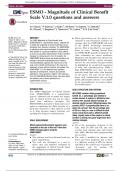Tentamen (uitwerkingen)
ESMO - Magnitude of Clinical Benefit Scale V.1.0 questions and answers
- Vak
- Instelling
If the ESMO-MCBS is only to be applied to comparative studies, what will that mean for breakthrough therapies, licenced on single arm data? Answer ▸ The grading of single arm data will be incorporated into version 1.1 of the ESMO-MCBS. Evaluation form 1—for new approaches to adjuvant the...
[Meer zien]



